The Hellenic Air Force hosted the Iniochos 2025 exercise at Andravida Air Base, with 12 countries actively participating in the largest edition since the first as Invitation Exercise in 2015.
Andravida Air Base in Greece hosted from Mar. 31 to Apr. 11, 2025, the latest edition of the Iniochos annual exercise. The Hellenic Air Force (HAF) said Iniochos 2025 marked the largest participation of air forces, with a total of 12 countries actively participating.
Iniochos is an annual large-scale multinational air exercise that provides participating forces with a high-end training environment, simulating complex and dynamic air combat scenarios. The goal is to replicate a complex and congested air environment, enabling aircrews to refine tactics, techniques, and procedures in a realistic operational setting.
This is achieved through missions executed in a high-tempo, day-and-night operational environment, covering the full spectrum of modern air operations within complex and realistic scenarios. The scenarios also included “real-time injects and modern threat simulations” to further improve the training.
Among the types of scenarios included are Offensive and Defensive Counter-Air Operations, Strategic Air Operations, Combat Search and Rescue, Integrated Air and Missile Defense (IAMD) and Time-Sensitive Targeting. “Iniochos offers a challenging and comprehensive air exercises for participating nations due to the challenging scenarios in a geographically diverse environment, making the exercise a key component in fostering multinational collaboration and airpower synergy,” says the NATO Allied Air Command.

Iniochos 2025
As already mentioned, Iniochos 2025 marked the largest participation of air forces, with a total of 12 countries actively participating. This edition saw the presence of:
- France with Mirage 2000Ds;
- India with Su-30MKIs;
- Israel with G-550s;
- Italy with Tornados in both IDS and ECR variants;
- Montenegro with Bell 412s;
- Poland with F-16Cs;
- Qatar with F-15QAs;
- Slovenia with PC-9Ms;
- Spain with EF-18Ms;
- United Arab Emirates with Mirage 2000-9s;
- United States with F-16Cs, KC-46s and KC-135s;
- Greece with all aircraft types in service.
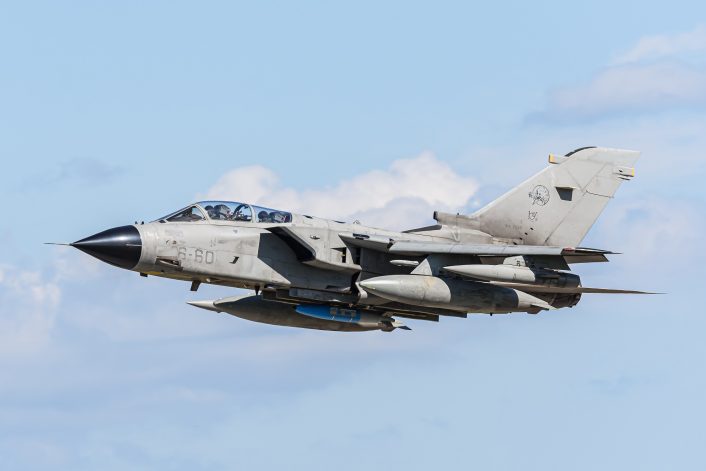
Among the participants were also units from the Hellenic Army, the Hellenic Navy, and the Special Warfare Command, which contributed significantly to the creation of complex and realistic operational scenarios, said the HAF. Among the observers were Bahrain, Cyprus, and Slovakia.
The HAF said at the end of the exercise that a total of 1,300 flight sorties were conducted throughout the Athens Flight Information Region (FIR). Concurrently, missions were also carried out using the Tactical Simulators of the F-16 at the Operational Synthetic Training Squadron of the Hellenic Air Tactics Center, adding a virtual component to the exercise.
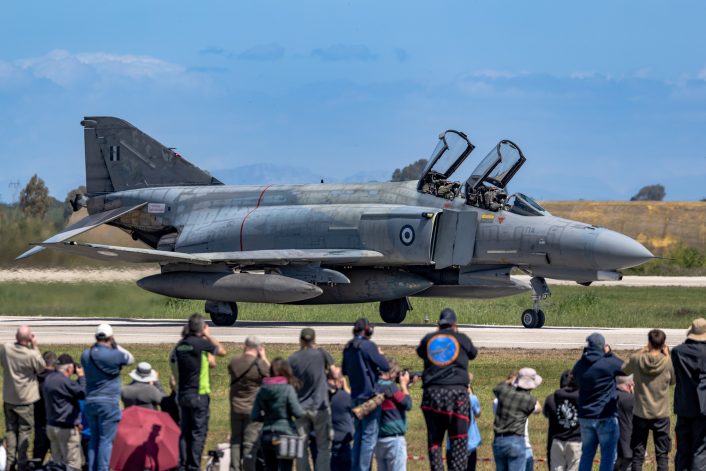
The exercise
The Iniochos exercise was first held by the Hellenic Air Force in the late 1980s as a small-scale tactical level exercise. At the time, the exercise was specifically tailored to the contemporary necessity for training in combined air operations in accordance with the HAF Doctrine.
Over the next years, the success of the exercise led to the decision on establishing it as an annual event. The objective was to train personnel in planning and execution of Combined Air Operations (COMAO) in a realistic environment, in order to test and evaluate operational plans and tactics.
The new annual exercise was initially held by the Hellenic Fighter Weapons School at Larissa Air Base, home of the 110 Combat Wing. In 2005, it was decided to decentralize the exercise, with the participating aircraft operating from their mother bases, while the planning and the coordination were overseen by the Air Tactics Center and the Fighter Weapons School at Andravida Air Base.

In November 2013, the exercise evolved with some drastic changes. Specifically, it was decided to adopt a single base concept, upgrade the exercise scale to medium and expand the spectrum of operations with the objective to create a more realistic and demanding environment, with an intensive and prolonged 24/7 battle rhythm, significantly increasing the level of training.
In April 2015, the exercise was held for the first time as INVITEX (Invitation Exercise), with the participation of the IAF and JTAC operators of the USAFE. Ten years later, in 2025, Andravida saw the largest participation of air forces to Iniochos, with a total of 12 countries actively participating.
Iniochos has two main objectives: provide realistic training in a realistic battle environment and provide accurate shot/event assessment.

The first objective is achieved through the exposure to an intensive battle rhythm with realistic attrition rates and challenging scenarios, which include multiple modern threats and real time live injects, tailored to produce the “fog of war” and the “friction effect.” These two effects are, in fact, “expected to dominate the modern battlefield and test both the physical and psychological endurance of the modern fighter,” says the HAF.
The second objective is achieved with the use of both onboard and offboard tracking data, sensors and specialized debriefing software. These are leveraged for the reconstruction of the mission by experienced Fighter Weapons School instructors, who oversee the debriefing process to maximize the training.
The HAF says the exercise has to cover the full spectrum of missions currently performed, including: air operations versus Integrated Air Defense System (IADS); Offensive Counter Air (OCA) / Airfield Attack; Air Interdiction / Special Targets (bridges, power stations, vehicles, etc); Anti-Surface Warfare; Slow Mover Protection (SLOMO); Combat Search and Rescue (CSAR); Dynamic Targeting (DT) / Strike Coordination and Reconnaissance (SCAR) / Close Air Support (CAS) / Time Sensitive Targets (TST); High Value Airborne Asset (HVAA) Protect/Attack.
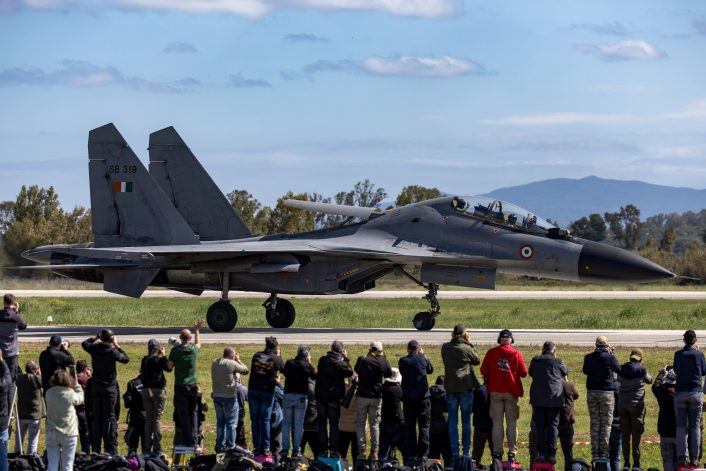
The Spotters Day
This year, our friend and aviation photographer Jerry McGrath had a chance to attend the Spotters Day for Iniochos 2025 at Andravida, where he captured some great photos which you can find in this article. Over one thousand spotters were there on Apr. 7 for the occasion.
“Iniochos Spotters day 2025 was a blast…and a massive success!” McGrath told us. Spotters experienced a sunny, breezy day near Andravida’s control tower, with aircraft parading in front of them and taking off in rapid succession.
The locals started the flight activities before the first exercise mission of the day. “338 Squadron kicked the day off with a roar, launching a pair of F-4E AUP Phantoms to entertain the gathering crowd with simulated ground attacks and cross patterns, showing the spotters that the old planes still had a lot of kick left in them,” said McGrath.

The first to launch for the day’s Iniochos missions were the F-16s of the 93rd FS “Fighting Makos” F-16’s from Homestead AFB, Florida. In quick succession, the USAF F-16Cs, Slovenian PC-9Ms, Italian Tornados, Qatari F-15QAs and French Mirage 2000s departed for the first wave.
“You could barely catch your breath in time for the Indians to bring out their prized Su-30MKI’s on a slow taxi past the gathered spotters,” told us McGrath. “They muscled their planes into the air on short take offs and sheer power climbs from mid-field, three in a row.”
The last to launch were the Polish F-16Cs and the local F-4E AUPs, completing the departing of the morning mission. When time came up for the recovery, most opted for single, direct landings, while Polish and Indian aircraft delighted the crowd with formation flights over the air base and overhead breaks for the landing.
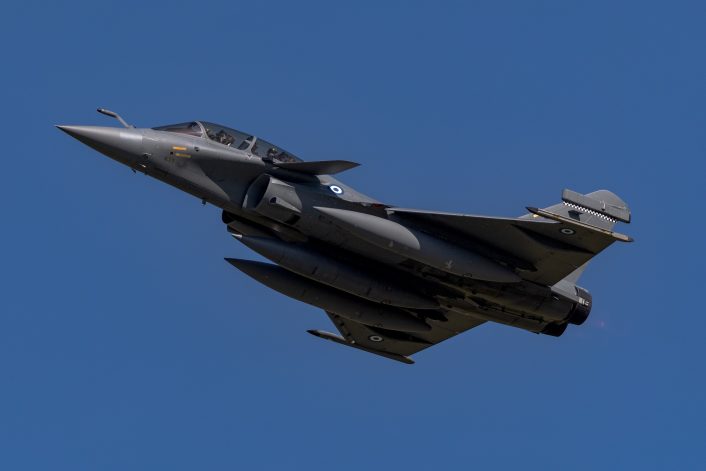
Then it was time for the afternoon mission, introduced by 12 Greek F-16s, of which four from 341 Mira and eight from 347 Mira, flying over Andravida. Shortly thereafter, eight USAF F-16s and four Greek F-16s from 340 Mira launched and followed the first formation.
Four Greek Rafales then line up and take off, followed by three more Greek F-16s, this time from 330 Mira, which flew over the air base. After the flyover, it was the turn of the Italian Tornados, Polish F-16s, Greek F-4s and, finally, Greek Mirage 2000s.
Later in the afternoon, time came for the recovery. “Americans, Polish and Greeks all flew back in formation. Tornadoes came back in pairs,” said McGrath. “And like that…it was over.”

The “Greek Mach Loop”
During their stay in Greece, the foreign aircraft taking part in the exercise had a chance to exploit one of the canyons located in the northwest of the Peloponnese peninsula, regularly used for low level flying by the Hellenic Air Force aircraft. While nowadays military aircraft mostly operate at medium altitude, depending on the scenario, pilots may still need to operate at low level and, for this reason, air forces continue to train for this.
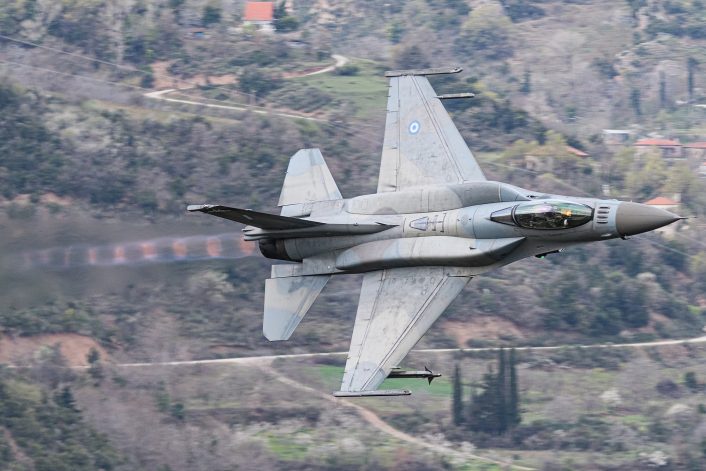
This year, once again, many aviation enthusiasts, photographers and spotters have climbed the hills in the so-called “Greek Mach Loop” (for its resemblance to the famous UK Low Flying Areas) to take photos and videos of the low flying aircraft, with some stunning results.
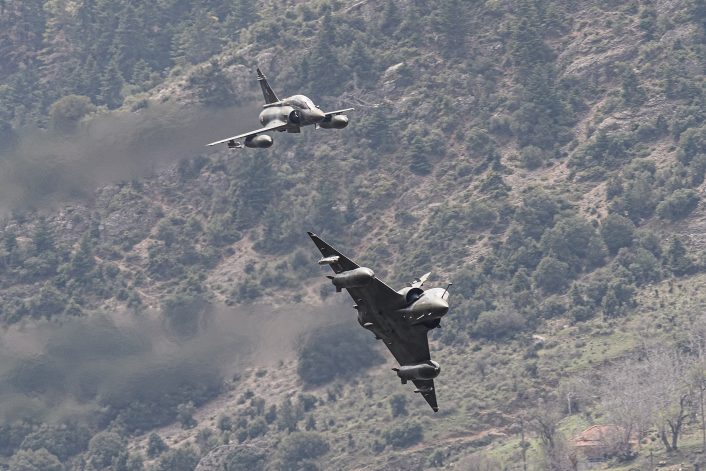
The region has now become a favorite destination for aviation enthusiasts, photographers, and spotters, and many can be seen venturing in the area to find the perfect spot from which they can capture breathtaking views of military aircraft as they navigate through the canyon whenever there is a major exercise in progress.
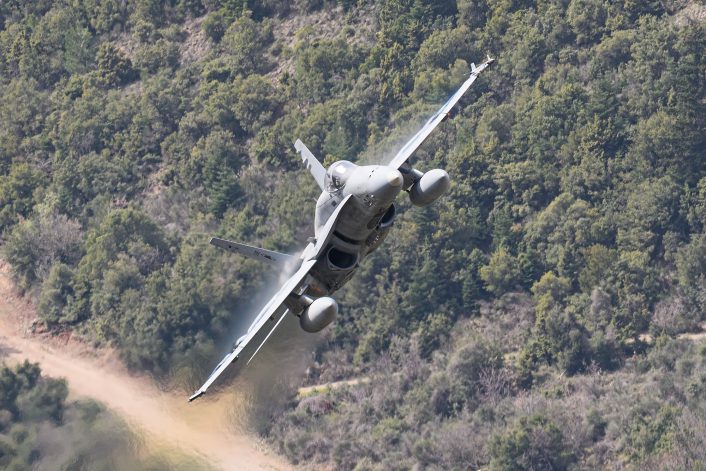
Among them, for Iniochos 2025, was our contributor Alessandro Fucito, who went there on Mar. 27, 2025, as participants conducted local training flight before the start of the exercise.
Tens of aviation enthusiasts were there, especially in the days before the official start of the exercise, from Mar. 24 to 31. As if the photos were not spectacular enough, many photographers also captured videos showing the aircraft flying low and fast in the stunning scenery of the canyon.
Thanks again to Jerry McGrath for the photos he sent us and the help he provided in the preparation of this article. Make sure to follow him on Instagram for more!









